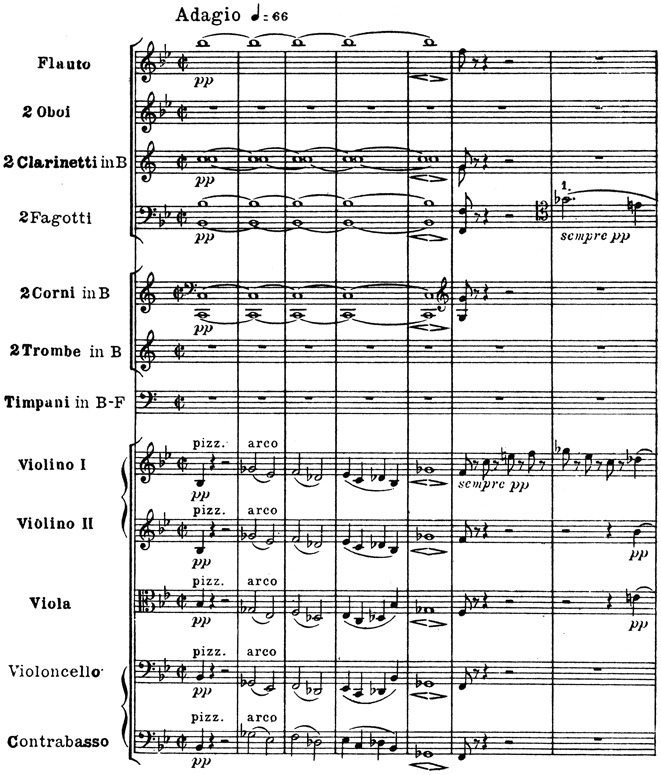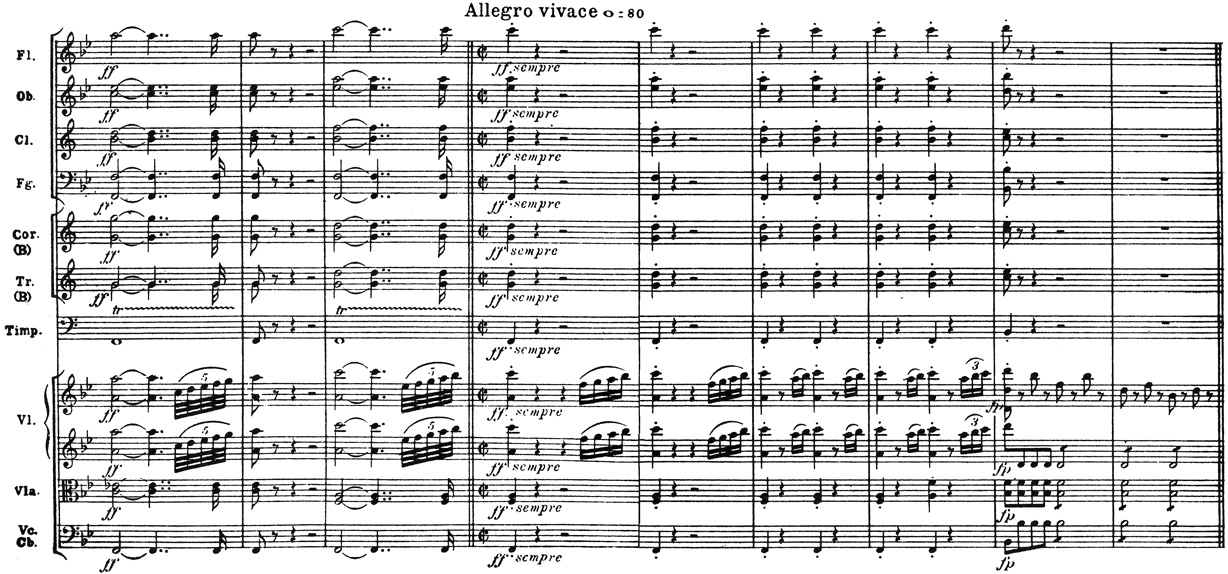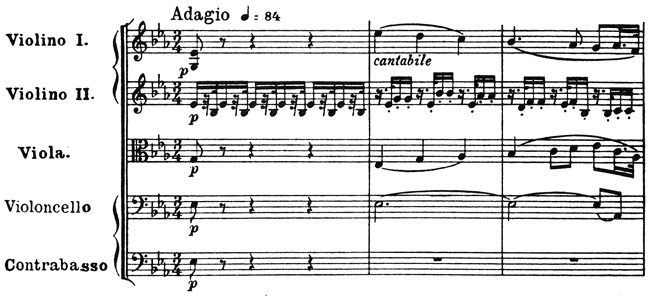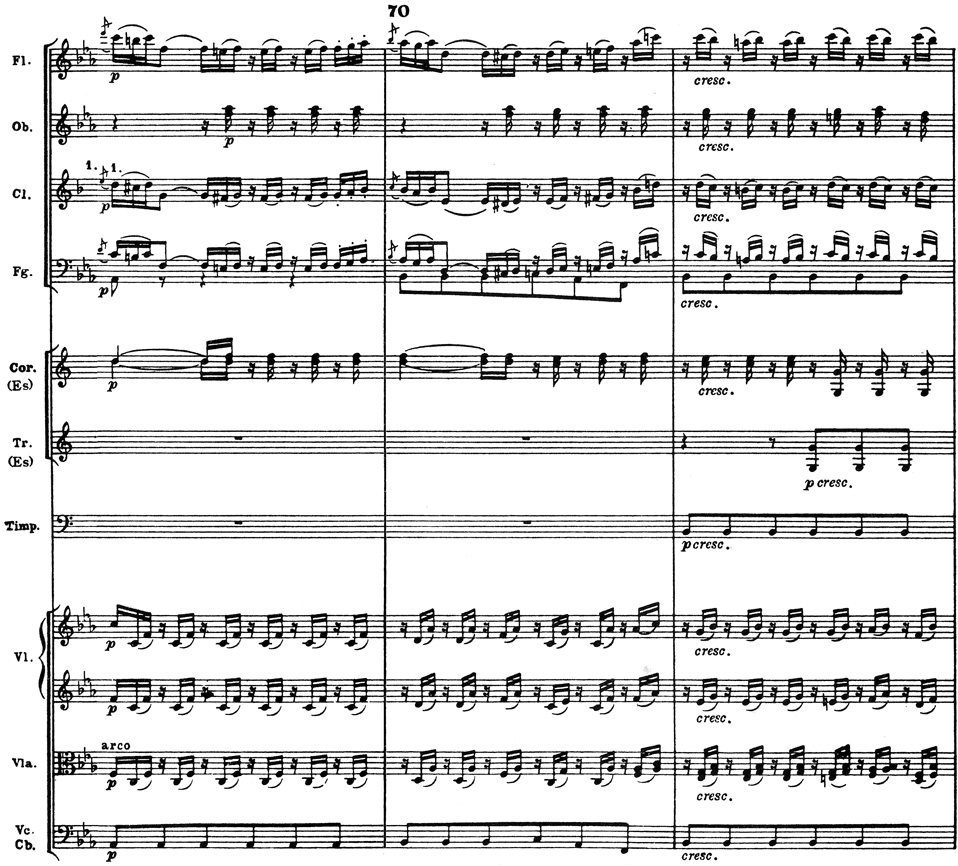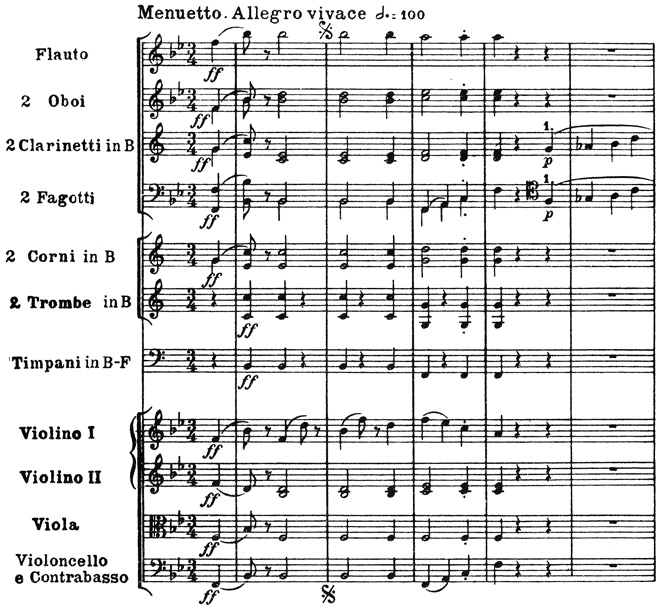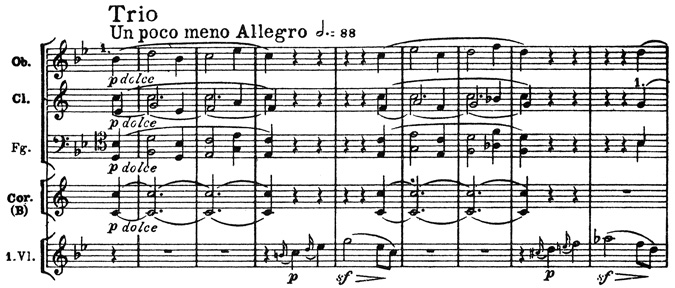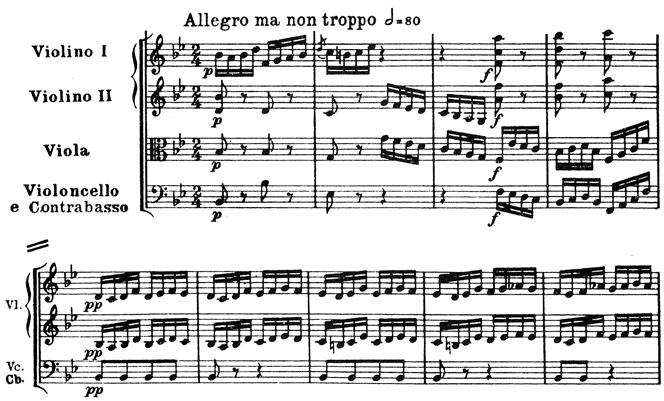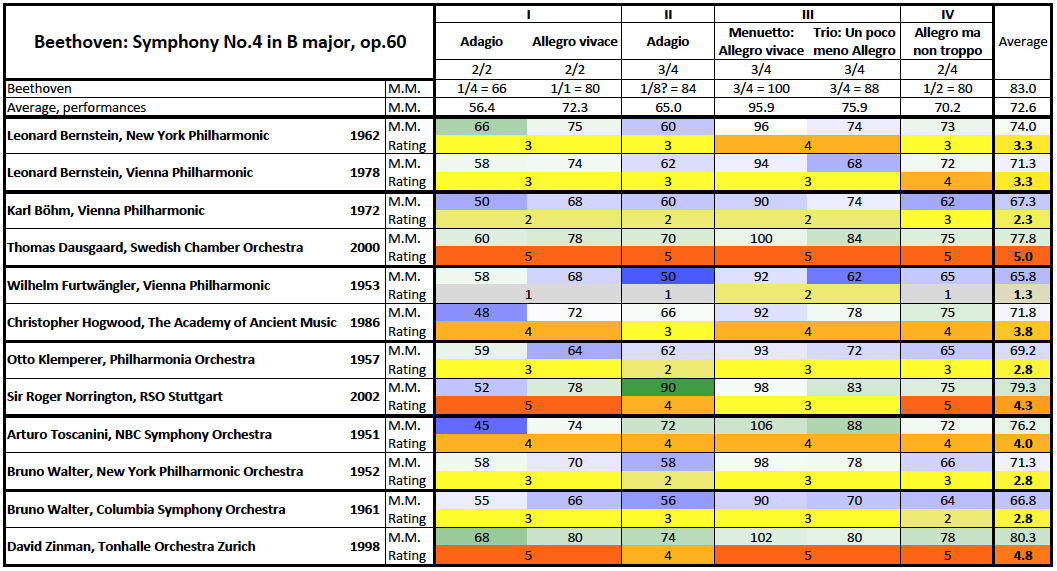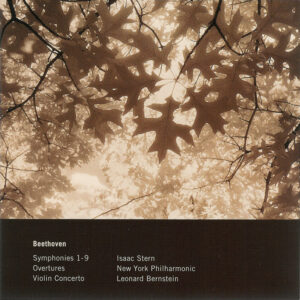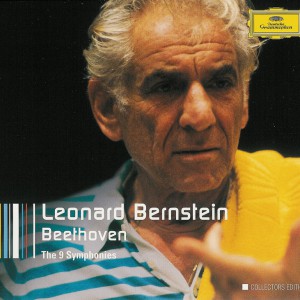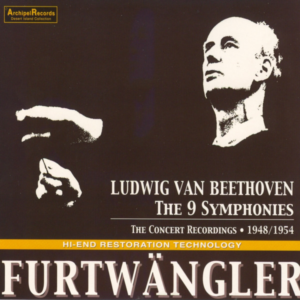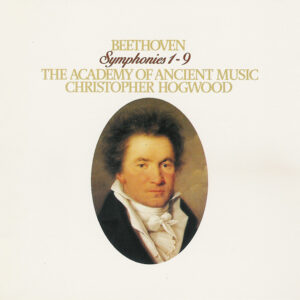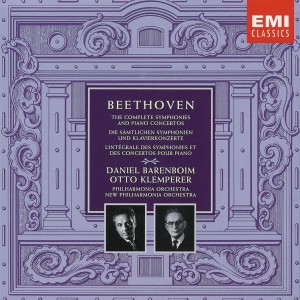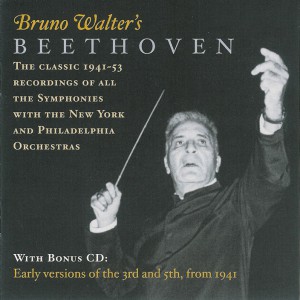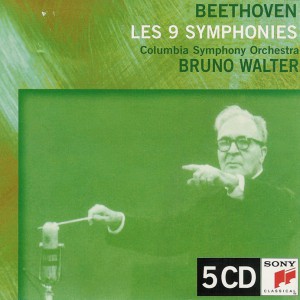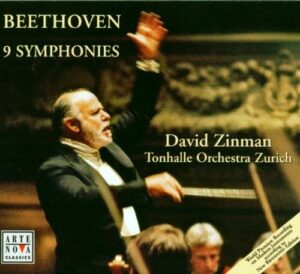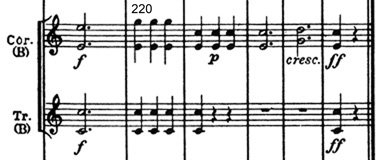Ludwig van Beethoven
Symphony No.4 in B♭ major, op.60
Media Review / Comparison
2015-01-06 — Original posting
2015-08-20 — Added reference to Zinman’s complete symphony recording
2016-07-31 — Brushed up for better readability
Table of Contents
- Introduction / The Recordings
- Background, About the Composition
- The Interpretations, Overview
- The Interpretations, Detail
- Leonard Bernstein, New York Philharmonic Orchestra (1962)
- Leonard Bernstein, Vienna Philharmonic (1978)
- Karl Böhm, Vienna Philharmonic (1972)
- Thomas Dausgaard, Swedish Chamber Orchestra Örebro (2000)
- Wilhelm Furtwängler, Vienna Philharmonic (1953)
- Christopher Hogwood, The Academy of Ancient Music (1986)
- Otto Klemperer, Philharmonia Orchestra (1957)
- Sir Roger Norrington, Radio-Sinfonieorchester Stuttgart (2002)
- Arturo Toscanini, NBC Symphony Orchestra (1951)
- Bruno Walter, New York Philharmonic Orchestra (1952)
- Bruno Walter, Columbia Symphony Orchestra (1961)
- David Zinman, Tonhalle Orchestra Zurich (1998)
- Addendum 1
- Addendum 2
Introduction / The Recordings
This posting is about Ludwig van Beethoven’s Symphony No.4 in B♭ major, op.60, of which I currently have 12 recordings — in chronological order:
- Arturo Toscanini, NBC Symphony Orchestra (1951)
- Bruno Walter, New York Philharmonic Orchestra (1952)
- Wilhelm Furtwängler, Vienna Philharmonic (1953)
- Otto Klemperer, Philharmonia Orchestra (1957)
- Bruno Walter, Columbia Symphony Orchestra (1961)
- Leonard Bernstein, New York Philharmonic Orchestra (1962)
- Karl Böhm, Vienna Philharmonic (1972)
- Leonard Bernstein, Vienna Philharmonic (1978)
- Christopher Hogwood, The Academy of Ancient Music (1986)
- David Zinman, Tonhalle Orchestra Zurich (1998)
- Thomas Dausgaard, Swedish Chamber Orchestra Örebro (2000)
- Sir Roger Norrington, Radio-Sinfonieorchester Stuttgart (2002)
Most of the older recordings — up to and including Bernstein with the Vienna Philharmonics — are also present in my LP collection, the last four were added more recently, in order also to have current interpretations for comparison.
In the discussion below, I deal with the recordings in alphabetic order. My listening sequence is neither alphabetic nor chronological.
Background, About the Composition
Ludwig van Beethoven (1770 – 1827) wrote his Symphony No.4 in B♭ major, op.60, in 1806. It’s a typical example of his serene “even” symphonies (2, 4, 6, 8), which alternate with his more dramatic & expressive “odd” symphonies (3, 5, 7). The symphony follows the typical, classic scheme with four movements —
The Movements
I. Adagio, 2/2 (1/4 = 66) — Allegro vivace, 2/2 (1/1 = 80)
The first movement starts with a slow introduction, annotated Adagio:
Note, however, that the movement is written alla breve — two beats per bar — and with 1/4 = 66, the tempo is substantially faster than typically expected and performed! With the slow tempo in many traditional performances, the alla breve character gets lost, and the introduction also tends to lose tension. The introduction (38 bars) is followed by the joyful, jumping first theme of a sonata movement, whereby the exposition (bars 45 – 184) is repeated. Beethoven wrote dedicated endings for the two passes. This indicates that the repeat signs were more than just convention / tradition: I don’t think the repetition should be taken as ad libitum! Note that also here, the tempo is faster than typically expected. But, as some examples below demonstrate, it is perfectly doable (though it does require a good, virtuosic orchestra!).
The first movement is 498 bars total (696 bars with the repeat).
II. Adagio, 3/4 (1/8 [1/4??] = 84)
A seemingly simple movement, Adagio, 3/4 (104 bars). However, Beethoven specifies 1/8 = 84 (the crotchet in the score for sure must be a mistake / typo!), which is way faster than what is traditionally performed:
The key is in the cantabile — e.g., in the first violin, bar 2. To me, this implies that this is a melody that must be singable, and with 1/4 = 50 – 60, this is clearly impossible to sing, not only because a singer would run out of breath, but also because the melody is stretched beyond recognition. Listening through the recordings below revealed one more thing: while it is certainly possible to play Beethoven’s tempo with vibrato, playing without vibrato (the norm up to the early 20th century) makes slow playing in this movement almost unbearable. This also explains Beethoven’s tempo annotation!
Bruno Walter correctly states that this is maybe the most difficult symphony movement in all of Beethoven: not just because of the tempo issue, but also because of its rhythmic intricacies, such as in bars 69 – 71, where oboes and horns are playing semiquaver notes on the odd beats, which (theoretically) must fall into the center of the middle note in semiquaver triplets played by most other voices. Even some prominent conductors & orchestras shamefully hide away this detail:
III. Menuetto: Allegro vivace, 3/4 (3/4 = 100) — Trio: Un poco meno Allegro, 3/4 (3/4 = 88)
The tempo selection for this movement (224 bars, not counting any repeats) is fairly coherent throughout the recordings, and not too far below Beethoven’s annotation (in the Menuetto, Toscanini and Zinman are faster, in the Trio, only Toscanini matches Beethoven’s tempo). It’s a rather wild Menuetto — often almost boisterous:
The Menuetto consists of two parts (20 + 70 bars), both with repeat signs, the Trio (84 bars) has no repeat signs:
Both the Scherzo and the Trio are to be repeated at the end of the first pass, and the movement ends with an abbreviated Menuetto section of 44 bars. The entire scheme can be outlined as AABB – Trio – AB – Trio – A’B’ (466 bars); Christopher Hogwood even does the repeats also in the second Menuetto pass, i.e., he uses a scheme AABB – Trio – AABB – Trio – A’B’ (556 bars).
IV. Allegro ma non troppo, 2/4 (1/2 = 80)
The symphony ends with a real virtuosic, brilliant showpiece, requiring excellent coordination in the string sections (and equally demanding on the bassoon, when it gets to play the same figures as the strings!):
It’s a sonata movement where — as usual — the exposition is repeated. The ending is a typical, nice / fun Beethoven joke / surprise. I’m sure people in a contemporary audience have had a good laugh about this (today’s audiences are far too serious to even notice the joke, unless they are told about it!). The movement is 355 bars (458 bars with the repeat).
The Interpretations, Overview
In order to provide a rating overview, as well as an idea about tempo relations both within an interpretation, as well as between the two recordings, I have prepared the little table below. Note that the color coding for the tempo (blue = slower, green = faster) refers to the average between the recordings, not to the metronome markings in the score:
The ratings should be clear (1 = lowest/gray, 3 = yellow, 5 = highest/orange) — these are meant to be my personal opinion and relative, not absolute.
The Interpretations, Detail
As mentioned above, I’m discussing the interpretations in alphabetic order (by the conductor’s last name). Note, however, that this is not the order in which I did the comparison: in the listening order, I try grouping similar recordings together, also typically listening to slower performances prior to faster ones, as I feel that this is the best way to do justice to every recording. Keep in mind that even if I make lots of critical comments to a given recording, this does not imply that I didn’t enjoy the music, even though I can’t deny that I’m in favor of historically informed performances: many of the older recordings definitely retain their historic value, and most of them are still interesting to listen to!
Leonard Bernstein, New York Philharmonic Orchestra (1962)
Beethoven: Symphonies 1 – 9, Overtures, Violin Concerto
Leonard Bernstein, New York Philharmonic Orchestra
Isaac Stern
Sony Classical SB6K 87885 (6 CDs, stereo); ℗ 1959 – 1970 / © 2002
Booklet: track listing only

This is from the earlier cycle of stereo recordings of all Beethoven symphonies that Leonard Bernstein (1918 – 1990) made with the New York Philharmonic Orchestra. The CD release also includes Overtures and the violin concerto, with Isaac Stern. Symphony No.4 was recorded in 1962. Orchestra arrangement: Vl 1 — Vl 2 — Vla — Vc
Notes on the Movements
I. Adagio, 2/2 — Allegro vivace, 2/2
Adagio —Allegro vivace
Duration: 10’41”
In the Adagio introduction, this is one of very few sticking to Beethoven’s tempo marking, and also the Allegro vivace is close to the composer’s annotation, with 1/1 = 75 (LvB: 80). With an orchestra of that size, though, this comes at the price of often sounding pushed, if not rushed (the same can be observed in Bernstein’s last recording), and also syncopes and accents appear pushed, sudden rhythm changes don’t get the proper time & attention (see the newer recording below). In the introduction, the pp (to me) is too loud, the string sound in general more coarse than with the Vienna Philharmonics, and also the woodwinds are less smooth in sound and mixing with the rest of the orchestra. Overall, though, still an interpretation with drive and rhythm.
II. Adagio, 3/4
Duration: 9’56”
Compared to the more recent recording below (with the Vienna Philharmonics), this one is less intimate, less sweet, but now somewhat coarse, especially in the woodwinds, with too much vibrato in the Flute. But Bernstein is careful about rhythmic details, as shown in bars 69ff. (see the score sample above).
III. Menuetto: Allegro vivace, 3/4 — Trio: Un poco meno Allegro, 3/4
Duration: 5’36”
I prefer this over Bernstein’s more recent interpretation with the Vienna Philharmonics: it’s closer to Beethoven’s tempo annotations, more moderate in the ff parts, more balanced overall. Being Bernstein’s interpretation, it is of course full of swing and momentum: quite enthralling in a good sense!
IV. Allegro ma non troppo, 2/4
Duration: 6’37”
Compared to the more recent recording with the Vienna Philharmonics, this one is somewhat more extroverted, with some superficialities (e.g., the final notes in fast bars), details are lost due to lacking transparency (e.g.: the second clarinet in bars 215ff., second voices in various places), the lack if left-right antagonism between the two violin voices is a real pity. In general, I think the orchestra is working at its limits (coordination!) at this tempo. The only part which is better than in the recording with the Vienna Philharmonics is the Coda.
Overall Duration: 32’50“
Rating (see above for details): 3.3 — Overall, I rate this about the same as Bernstein’s more recent recording (see below); in the third movement, though, I prefer this one.
Leonard Bernstein, Vienna Philharmonic (1978)
Beethoven: Symphonies 1 – 9
Leonard Bernstein, Vienna Philharmonic
DG 474 924-2 (5 CDs, stereo); ℗ 1980/2004 / © 1981
Booklet: 24 pp. en/de/fr

This is the more recent complete recording of all Beethoven symphonies by Leonard Bernstein (1918 – 1990), this time with the Vienna Philharmonics. The symphony No.4 was recorded in 1978. Orchestra arrangement: Vl 1 — Vl 2 — Vla — Vc
Notes on the Movements
I. Adagio, 2/2 — Allegro vivace, 2/2
Duration: 11’29”
One can certainly not blame this recording for lacking tension and drive: Bernstein’s strength is his dynamic, often “sporty” direction (one can hear him jump at the beginning of the Allegro vivace!), but maybe less in the ultimate detail in articulation. Indeed, there are some superficialities in the articulation, and occasionally, Bernstein seems to lack the patience / strength to hold back a tiny moment in order to let an accent / sforzato, or a syncope stand out clearly. In bar 373, a syncopated rhythm is disrupted by a staccato note on the first beat. This appears rushed / unclear, suppressing the effect (presumably) intended by the composer (strange because I always felt that rhythm is Bernstein’s real strength!).
II. Adagio, 3/4
Duration: 10’02”
The tempo is about as slow as Karl Böhm‘s. But the movement is played with much more expression. Too much expression, indeed: I’m sure it’s all heartfelt by the conductor. But from CD, the melody sounds far too sweet, with too much vibrato. Accents are softened, and there is too much rallentando and broadening at the end.
III. Menuetto: Allegro vivace, 3/4 — Trio: Un poco meno Allegro, 3/4
Duration: 5’57”
Traditional from the overall sound (big orchestra), rhythmically sometimes a bit over-accentuated. The tempo difference from the Menuetto to the Trio is rather big, compared to Beethoven’s annotation, i.e., to me, the Trio is somewhat dragging.
IV. Allegro ma non troppo, 2/4
Duration: 6’49”
Not as coherent as Toscanini, and sad.ly lacking the left-right dialogs between the violins, due to the “wrong” orchestra arrangement. Avoids excess “polish” and percussive articulation. In the bars leading into the Coda (bars 303ff., up to first fermata), the downward scales in the lower string voices are very impressive! After the first fermata (bar 318), Bernstein misses the chance to build tension, the cello continues without interruption: too bad! Also, the early ritardandi in the Coda spoil parts of the surprise / joke.
Overall Duration: 34’16“
Rating (see above for details): 3.3 — A good, “classic” interpretation. In the last movement, I prefer it over Bernstein’s earlier recording(s).
Karl Böhm, Vienna Philharmonic (1972)
Beethoven: Symphonies 1, 2, 4, 5
Karl Böhm, Vienna Philharmonic
DG / iTunes download (2 CDs, stereo, 256 kbps); ℗ 2004
Booklet: none

Karl Böhm (1894 – 1981) recorded the Symphony No.4 in 1972, as part of a complete cycle, with the Vienna Philharmonic Orchestra. I remember Karl Böhm as the person who stated in a TV interview “I have a natural feeling for the right tempo.” — so he thought! On the positive side: Böhm’s orchestra arrangement is Vl 1 — Vla — Vc — Vl 2. I already had this recording on LP — not out of real, genuine and specific interest, but more because I then felt it is a “reference recording” that one “must” have. Well…
Notes on the Movements
I. Adagio, 2/2 — Allegro vivace, 2/2
Duration: 12’11”
The sound of a big orchestra, and definitely a good orchestra, of course; everything is played as given in the score — but just that: to me, the introduction lacks tension. There is a slight accelerando over the first 38 bars, but that’s not adding tension — quite to the contrary. In the Allegro vivace part, the second theme is played slightly slower, but otherwise, the tempo is kept straight. To me, the interpretation is rather uninspired, lacking dynamic and agogic elasticity. Even though I can’t really point to anything really wrong or missing (other than an occasional tendency towards broad articulation, maybe, and the romantic orchestra size as such), to me this does not offer much excitement at all.
II. Adagio, 3/4
Duration: 9’45”
As slow as Otto Klemperer‘s interpretation, but flatter, both dynamically, as well as in phrasing and articulation, and with too much vibrato. Rather boring.
III. Menuetto: Allegro vivace, 3/4 — Trio: Un poco meno Allegro, 3/4
Duration: 5’55”
A Minuet? Rather a military march (of sorts), at least in the ff parts; the lyrical sections / voices are often extremely legato & broad in articulation.
IV. Allegro ma non troppo, 2/4
Duration: 7’24”
Carefully played, transparent, clear (for the size of the orchestra), with nice woodwinds (bassoons, clarinets), e.g., in bars 37ff. (though clearly enhanced by the recording technician!). But altogether too well-behaved (the slowest performance in this comparison), very little, if any, agogics — still the best of Böhm’s movements in this symphony.
Overall Duration: 35’12”
Rating (see above for details): 2.3 — I would not recommend this, other than to hard-core Böhm fans…
Thomas Dausgaard, Swedish Chamber Orchestra Örebro (2000)
Beethoven: Symphonies 4 & 5, Coriolan Overture
Thomas Dausgaard, Swedish Chamber Orchestra Örebro
Simax classics/ iTunes download (CD, stereo, 256 kbps); ℗ 2000
Booklet: none

Since 1997, Thomas Dausgaard (*1963) is the principal conductor of the Swedish Chamber Orchestra in Örebro. In 2009 he started a big project of recording all of Beethoven’s orchestral works with this ensemble. So far, all symphonies are done, most of the concertos (the piano concertos are played by Boris Berezovsky), plus some other works, such as overtures, and “Die Geschöpfe des Prometheus”. For the symphonies (like David Zinman), Thomas Dausgaard uses Jonathan del Mar’s new Beethoven edition (Bärenreiter). The orchestra plays with modern instruments, but essentially without vibrato, and of course using wooden drum sticks for the timpani. This symphony was recorded in 2000. The two violin voices are placed on opposite sides of the podium, i.e., the orchestra arrangement is Vl 1 — Vla — Vc — Vl 2
Notes on the Movements
I. Adagio, 2/2 — Allegro vivace, 2/2
Duration: 11’05”
A small orchestra with excellent transparency and balance, very nice woodwinds, and I like the added clarity through the absence of vibrato! Dausgaard’s tempo is close to Beethoven’s (hence also close to David Zinman‘s), the articulation is light, but slightly softer and less polished (more elastic, more “human”) than with the Tonhalle Orchestra / Zinman. Unlike apparently the new Beethoven edition, the ornaments in bars 223, 227 & equivalents are played as acciaccaturas (hence more closely following what a typical audience may expect). One remarkable detail is how the orchestral placement exposes those nice dialogs between the two (opposing) violin voices. Even though the instruments are (likely) modern, I call this a true HIP recording, and I prefer it over Christopher Hogwood’s!
II. Adagio, 3/4
Duration: 8’44”
Dausgaard remains below Beethoven’s metronome mark and is slightly slower than Toscanini and Zinman — with the benefit that the movement remains truly Adagio (calm), the melody is cantabile and singable, and at the same time the accompaniment is not nervous, thanks to a nicely soft articulation. But the performance is still precise, covering a wide dynamic scope from pp to ff, with excellent articulation. Bars 69ff. with the intricate, fast “2 vs. 3” rhythm is as clear as in none of the other interpretations. very nice, and not extroverted, even in the ff sections!
III. Menuetto: Allegro vivace, 3/4 — Trio: Un poco meno Allegro, 3/4
Duration: 5’29”
An excellent interpretation! I’m comparing this mainly to Zinman‘s recording, and this one is really excellent, almost exactly at Beethoven’s metronome marks, yet never really pushed or rushed, but joyful, natural / “human”, with light articulation, discharging the ff notes, simply very good, indeed! One little detail: in bars 35 – 52, bassoon and cello play a slow melody (3/2 and 3/4 notes) in unison, accompanied by short motifs in the other voices.
In traditional interpretations with big orchestra, the bassoon is often partially or fully hidden behind the cello voice. Here, it even has slightly more weight than the cello, and it is the first time (I listened to Dausgaard last) where I really became aware of this voice — a nice feature! Needless to say that in the final bars (see Zinman‘s interpretation below) Dausgaard is faithful to the dynamics in the score, with the crescendo only starting with the final 3/4 note.
IV. Allegro ma non troppo, 2/4
Duration: 6’29”
Compared to Zinman‘s recording, the tempo is slightly more moderate, enough — along with the smaller chamber orchestra setup — to make this interpretation more relaxed (and less polished), stress-free (less of a virtuoso showpiece), without giving up the good features in Zinman’s recording: excellent transparency, acoustic balance, the added benefit of the two violin voices doing a left-right dialog: clearly the interpretation that I like most! As in Zinman‘s recording, the Coda is excellent, following the dynamic annotations. I’m not quite sure, but it could well be that the pp beginning of the Coda is played with solo cello — I think this would be legitimate, and of course it avoids coordination issues.
Overall Duration: 31’45”
Rating (see above for details): 5.0 — My favorite interpretation, no doubt!
Wilhelm Furtwängler, Vienna Philharmonic (1953)
Beethoven: Symphonies 1 – 9
Wilhelm Furtwängler, Vienna Philharmonic
Berlin Philharmonic, Philharmonia Orchestra, SDR Symphony Orchestra
live recordings 1948 – 1954
IMD Music Distribution Ltd. ARPCD 0214 (5 CDs, mono); ℗ / © 2004
Booklet: track listing only

This is from a collection of live concert recordings that Wilhelm Furtwängler (1886 – 1954) made 1948 – 1954, with various orchestras; this symphony was recorded in 1953, with the Vienna Philharmonic Orchestra.
Notes on the Movements
I. Adagio, 2/2 — Allegro vivace, 2/2
Duration: 10’16” — exposition not repeated
To me, clearly the oldest interpretation in style, unfortunately seriously hampered by coughing and other noises from the live audience, to a degree that makes it very hard to enjoy anything in this performance. The disk label says “Hi-end restoration technology”. All I hear from that is an attempt to make this a stereo recording, which of course it wasn’t and still isn’t. The restoration can’t reconstruct things that weren’t there in first place: the woodwind sound is fairly awful. Furtwängler adds lots of rubato and slows down the second theme, which disrupts the flow. Also, sforzati tend to be performed with an initial crescendo, not percussive, the short staccati in the introduction have intonation issues like with Klemperer, caused by an excess of (unnecessary) vibrato.
Also, in bar 223, the violins have an acciaccatura, followed by an equivalent in the in the woodwinds 4 bars later — the flute plays an appoggiatura. This can hardly be an accident and is obviously inconsequent: older scores showed acciaccaturas, newer scores change this to appoggiaturas. The notation has apparently been unclear, but whichever version is chosen, it should be played the same way in both instances (I suspect that most people in an audience would expect acciaccaturas). It’s not clear why the exposition was not repeated — were repeats regarded a nuisance back then?
II. Adagio, 3/4
Duration: 11’20”
Furtwängler takes this extremely slow; this may have worked for the concert audience. As audio-only experience, this (to me) is a complete failure: the melody line is overstretched beyond recognition; in the violins, in combination with extreme legato playing, it feels like molten cheese. On top of the slowness, the interpretation is overblown, exceedingly romantic, trying to make this a monumental piece (supported by the very big orchestra, of course). In the result, the melody is lost, the listener is focusing on motifs & accompaniment exclusively. Also, the abundant “taa — tataaa — tataa” rhythm (semiquaver — demisemiquaver rest, demisemiquaver), e.g., in the first bars, isn’t always very accurate, tends to be “washed out” into triplets. One mishap due to the live event is that in the last bars the timpani are out of tune.
III. Menuetto: Allegro vivace, 3/4 — Trio: Un poco meno Allegro, 3/4
Duration: 5’27”
Heavy, colossal, overblown, and an extreme tempo difference between Menuetto (3/4 = 92) and Trio (3/4 = 62) — not quite un poco meno Allegro!
IV. Allegro ma non troppo, 2/4
Duration: 7’06”
Pretty chaotic in the strings — due to Furtwängler’s notoriously vague, unclear (“inspiring”) direction? There are also rushed transitions, an excess of rubato. On top of that, the recording technique is really too limited to capture this performance (some of the loud passages are just noise); not much fun!
Overall Duration: 34’06”
Rating (see above for details): 1.3 — Certainly a historic document for Furtwängler fans, but really hard to listen to, due to limitations in the technique (and the added noise from the audience).
Christopher Hogwood, The Academy of Ancient Music (1986)
Beethoven: Symphonies 1 – 9, Overtures to “Coriolan” and “Egmont”
Christopher Hogwood, The Academy of Ancient Music
Decca / L’Oiseau-Lyre 425 z696-2 (6 CDs, stereo); ℗ 1986 – 89 / © 1989
Booklet: 90 pp. en/fr/de/it

Christopher Hogwood (1941 – 2014) made this recording of all Beethoven symphonies with the Academy of Ancient Music between 1983 and 1989. Symphony No.4 was recorded in 1986. This is the only real HIP (historically informed playing) in this comparison — instrument-wise, at least. The Academy of Ancient Music plays on authentic instruments, and Hogwood of course did check the relevant sources for the original notation, etc., and the orchestra is using the most favored arrangement of Beethoven’s time, with the two violin voices on either side of the podium: Vl 1 — Vla — Vc — Vl 2. By today’s HIP standards, Hogwood’s orchestra is maybe rather big, with 8 + 8 violins, 4 violas, 4 cellos, and 2 double basses.
One interesting fact: Hogwood directs the symphony from a fortepiano (he does this up to and including symphony No.4), though to the CD listener this is mostly inconspicuous: I only really noticed it towards the end of the second movement. The extensive booklet is also a comprehensive scientific documentation of Hogwood’s findings. The tuning in Hogwood’s recording is slightly below modern orchestral tuning (a’ = 430 rather than a’ = 440 – 442). That’s enough to cause momentary irritation in direct comparisons, but of course inconspicuous in a concert.
Notes on the Movements
I. Adagio, 2/2 — Allegro vivace, 2/2
Duration: 12’17”
Too bad Hogwood did not trust Beethoven’s metronome markings! For quite some time, many people believed that the metronome numbers in Beethoven’s scores were either not authentic, or that Beethoven’s metronome was simply broken. More recently, conductors such as Michael Gielen (1927 – 2019) or Sir Roger Norrington or (and followers such as Zinman and Dausgaard) have proven these metronome values not only to be playable, but that they make real sense! Hogwood’s introduction is almost as slow as Toscanini’s. It feels rather flat and lacks tension, and with 3’30” it also fills a substantial portion of the movement. The tempo in the Allegro vivace (1/1 = 72) is also somewhat slower than given by the score; yet, occasionally it feels slightly pushed in the violins.
The second theme is somewhat slower. The ornaments in bars 223 / 227ff. are (apparently correctly) played as appoggiaturas, which some listeners may find unusual. The big plus in this recording is in the use of authentic instruments, which (together with the smaller ensemble) yields a much better acoustic balance between woodwinds and strings. I like the timpani with the wooden drum sticks, the sound of the woodwinds! The coordination in the orchestra is very good in general, e.g., in the tremoli in the strings, though with occasional inaccuracies (such as in the rhythmic 2 vs. 3 detail in bars 69ff., shown in the score sample above), possibly a result of the direction from a fortepiano (which happens to be audible towards the end of this movement).
II. Adagio, 3/4
Duration: 9’58”
Quite far from Beethoven’s tempo, even though not as slow as some of the old recordings. With occasional coordination / precision issues, especially in the punctuated f / sf sections (greetings from Bruno Walter!). As expected, this is played without vibrato — but at 1/8 = 66, the melody lacks the cantabile character, is flat not only in tone, but also in emotion: it seems that playing without vibrato really asks for a tempo close to Beethoven’s specification of 1/8 = 84!
III. Menuetto: Allegro vivace, 3/4 — Trio: Un poco meno Allegro, 3/4
Duration: 6’35” — both Menuetto parts repeated also in the second pass
Compared to many traditional recordings that were popular (if not “the standard”) at the time of this recording: finally a performance that is joyful and not as martial (“military”) or overblown as many others! Unfortunately, the recording suffers from occasional coordination issues between woodwinds and the strings in the Menuetto part. Hogwood does both repeats even in the second pass of the Menuetto (see the text near the top). It’s hard to argue about this (other than stating that nobody else does it), as the score has no indications about the repeat pass — though one might ask why the Menuetto should be played 4 1/2 times and the Trio only twice?
IV. Allegro ma non troppo, 2/4
Duration: 6’41”
Hogwood’s interpretation of this movement is really good: the tempo is fast, close to Beethoven’s annotation — but at the limit for the orchestra (perhaps also because of the direction from the fortepiano?). One can hear that the transparency is suffering, sometimes, second voices are “drowning”, and occasionally the tempo starts to sound pushed & rushed. The Coda is excellent, avoiding unnecessary, premature ritardandi, hence really exposing Beethoven’s joke!
Overall Duration: 35’27”
Rating (see above for details): 3.8 — A good, early / pioneering HIP recording, meanwhile partially superseded by newer recordings that may provide an experience that is closer to Beethoven’s (alleged) intent, even without period instruments.
Otto Klemperer, Philharmonia Orchestra (1957)
Beethoven: The Complete Symphonies and Piano Concertos; Choral Fantasia; Great Fugue op.133; Overtures Leonore 1-3, Coriolan, Prometheus
Otto Klemperer, Philharmonia Orchestra, Daniel Barenboim
EMI 5 73895 2 (9 CDs, stereo); ℗ / © 2000

This is part of the complete cycle of Beethoven symphonies (later also including the piano concertos, with Daniel Barenboim and the New Philharmonia Orchestra) that Otto Klemperer (1885 – 1973) realized in the late fifties, with the Philharmonia Orchestra; Symphony No.4 was recorded in 1957 (Klemperer made one additional recording for a TV series celebrating Beethoven’s 200th birthday, around 1970). This first stereo recording was made at a time when Klemperer was already impaired from an accident and was forced to conduct from a chair; the tempo must already have been substantially slower than at the peak of his career. Orchestra arrangement: Vl 1 — Vla — Vc — Vl 2
Notes on the Movements
I. Adagio, 2/2 — Allegro vivace, 2/2
Duration: 12’28”
One can sense Otto Klemperer’s clear, strong conception in this music, his firm, sometimes heavy view on Beethoven (this movement can’t really be called heavy, but certainly isn’t lightweight playing). From today’s view, however, this recording has a few deficiencies that aren’t necessarily Klemperer’s fault, but based on limitations of the recording technique, the use of a big orchestra, which is stuck in traditions of romantic playing: there’s plenty of vibrato in the string sections, this hurts most in the short staccato in the violins, where it causes these short notes to lack purity in intonation. What bothers me more here is the fairly awful sound of the woodwinds, especially the oboes, and clarinets: the oboes sound like plastic instruments. But apart from that, it’s not a bad interpretation.
II. Adagio, 3/4
Duration: 10’01”
Rhythmically somewhat more accurate, and slightly faster than Furtwängler, but still too slow for the melody line. Occasional coordination issues (the size of the orchestra does not help here!).
III. Menuetto: Allegro vivace, 3/4 — Trio: Un poco meno Allegro, 3/4
Duration: 5’50”
Very determined, firm, rather strict (a rather wild Minuet / dance!), but nicely articulated, with good sound — better than Böhm, definitely.
IV. Allegro ma non troppo, 2/4
Duration: 7’39”
A tad faster than Böhm, but more vivid, more eruptive, with pretty good coordination within the strings (too much vibrato in the violins). About the sound of the oboes see the first movement above; occasionally, there is a tendency towards belly notes in the cello / double bass sections; a good, conventional interpretation.
Overall Duration: 35’56”
Rating (see above for details): 2.8 — One of the better conventional interpretations (I prefer it over Böhm, for instance)
Sir Roger Norrington, Radio-Sinfonieorchester Stuttgart (2002)
Beethoven: Symphonies 1 – 9, Introductions by Sir Roger Norrington
Sir Roger Norrington, Radio-Sinfonieorchester Stuttgart
Hänssler Classics (5 CDs + Bonus CD, stereo); ℗ 2000 / © 2000
Booklet: 17 pp. de/en (this CD)

Sir Roger Norrington (*1934) started his career in historically informed playing (HIP) with the London Classical Players, which he founded in 1978 and directed until 1997. 1998 – 2011 he directed the Radio Symphony Orchestra (RSO) Stuttgart, which he “re-educated” towards historically informed playing, without vibrato. In 2002, he conducted all Beethoven symphonies in commented concerts — and all these live performances were recorded.
The CD collection includes a bonus CD with Norrington’s introduction into various aspects of Beethoven’s symphonies, into HIP performance in general, discussing orchestra size and arrangement, the absence of vibrato, articulation, and — most importantly — questions of tempo and character of the various movements. The instruments are modern, though also here, the timpani are played with wooden drum sticks, and of course, Norrington uses the arrangement with the violin voices on opposite positions on the podium, i.e., Vl 1 — Vla — Vc — Vl 2. As these are live performances, one cannot expect the same degree of perfection as in Zinman’s recordings.
Notes on the Movements
I. Adagio, 2/2 — Allegro vivace, 2/2
Duration: 11’25”
To me, the symphony starts with a minor disappointment, in that Norrington falls short of his own rules, playing the Adagio substantially slower (1/4 = 52) than Beethoven’s own annotation (1/4 = 66) — with this, the alla breve measures are hardly noticeable. But that is my (almost) only criticism here: the Allegro vivace is at almost exactly Beethoven’s tempo, has drive, is vivid — excellent, overall! Sure, the orchestra is not as polished as the Tonhalle Orchestra. That’s also caused by the violins being spread over the entire width of the podium, and this on the other hand has the advantage of very nicely exposing Beethoven’s dialogs between the two violin voices (e.g., bars 68ff., 255ff., 312ff.).
The ornaments in bars 223, 227 and equivalents are played as appoggiaturas, as given in Jonathan del Mar’s new Beethoven edition (Bärenreiter). The final bars could perhaps be a little more concise, but that is likely attributable to the live (as opposed to studio) recording. I like the extra clarity (transparency and intonation) provided by the vibrato-less strings; for me, an excellent recording.
II. Adagio, 3/4
Duration: 7’32”
Maybe Norrington realized that the introduction to the first movement turned out slower than intended? Here, ne now beats Beethoven’s metronome mark by playing 1/8 = 90 — and the music is a little too fast. It’s hardly still Adagio, and the precision starts to suffer. Amazingly, one can still feel the intent to play bars 69ff. correctly (see the score sample above), though at this tempo the rhythm in this passage is difficult to follow exactly.
III. Menuetto: Allegro vivace, 3/4 — Trio: Un poco meno Allegro, 3/4
Duration: 5’30”
Norrington is close to Beethoven’s tempo annotations, the basic interpretation is very good. Unfortunately, the performance suffers from rhythmic inaccuracies /superficialities in the articulation in the Menuetto part (particularly in the ff parts), and in the Trio, some of the violin interjections (see the score sample above) sound rushed. Is the orchestra reaching its limits?
IV. Allegro ma non troppo, 2/4
Duration: 6’40” without applause
An excellent interpretation; probably at the very limit of the orchestra’s abilities. But then, this deserves a bonus for a live concert recording. The transparency is excellent (much better that in Hogwood‘s recording), and I really like Norrington’s interpretation of the Coda: this certainly brings Beethoven’s joke to life!
Overall Duration: 31’54“ (incl. applause); in addition: extra track with Norrington’s introduction (7’29”)
Rating (see above for details): 4.3 — A very good, “HIP-like” interpretation — the main limitations are probably those of the orchestra.
Arturo Toscanini, NBC Symphony Orchestra (1951)
Beethoven: Symphonies 1 – 9
Arturo Toscanini, NBC Symphony Orchestra
(recorded 1951 – 53)
RCA / BMG Classics 828786-55702-2 (5 CDs, mono); ℗ / © 2003
Booklet: 63 pp. en/de/fr

In 1949 – 1952, Arturo Toscanini (1867 – 1957) performed all Beethoven symphonies with the NBC Symphony Orchestra, at Carnegie Hall, mostly for direct radio broadcasts; it’s his last performance of the complete cycle, a key part of Toscanini’s legacy. The Symphony No.4 was recorded live and broadcast on 1951-02-03.
Notes on the Movements
I. Adagio, 2/2 — Allegro vivace, 2/2
Duration: 9’57” — exposition not repeated
A typical Toscanini performance: rhythmically very controlled and firm, avoiding all unnecessary romanticisms. Many of Toscanini’s recordings sound almost modern, even today! The latter is especially true for Toscanini’s tempo selections, at least in the fast movements. Toscanini uses limited agogics, his tempo can often be characterized as relentless — with the one exception of a slow-down in the second theme, around bar 107ff., or in the successive, transitioning scales around bar 290ff.
Like other conductors from that period (Furtwängler, Walter), Toscanini does not repeat the exposition. To me, this creates somewhat of a (minor) problem, in that Toscanini’s Adagio introduction is very slow (the slowest in this comparison, see the table above), and with without the repeat of the exposition, the introduction now occupies a full third of the movement (3’20” out of 9’57”), which I think is out of balance (in the case of David Zinman, using Beethoven’s metronome values, the introduction is a mere 20% of the movement’s time, though of course with the exposition being repeated).
II. Adagio, 3/4
Duration: 8’48”
A fairly good tempo: slower than specified in the score, but almost as fast as Zinman. Though, it often sounds a bit pushed: likely Toscanini beating the orchestra past existing tempo conventions! Toscanini subordinates everything to the cantabile, i.e., the melody line is key in this interpretation, but definitely without the larmoyance in Bernstein’s last recording. Also, Toscanini appears inspired by opera, injecting drama through added stringendi / compressions. Clearly the best of the historic performances in this movement. But Toscanini is also meticulous about following the notation — he certainly gets bars 69ff. (see the score sample above) right!
III. Menuetto: Allegro vivace, 3/4 — Trio: Un poco meno Allegro, 3/4
Duration: 5’00”
In view of traditional interpretations, Beethoven’s annotations are typically considered fast. But here, in the Menuetto, Toscanini manages to be faster (the only other exception in this comparison is Sir Roger Norrington in the second movement). The Trio is following Beethoven’s metronome annotation, so the tempo difference between the two sections is slightly bigger than intended by the composer. For me, it’s too forceful in the Menuetto (in today’s view) to be a real top interpretation, but I can’t deny that both parts have lots of drive. It’s an interesting interpretation anyway, even though it is far away from what people perceive as a typical Minuet!
IV. Allegro ma non troppo, 2/4
Duration: 6’57”
Technically, the performance of the orchestra is simply excellent, considering the size of the ensemble, maybe with the exception of the first 10 bars where the musicians take a while to reach perfect coordination. Toscanini’s interpretation is enthralling, is relentless, has drive, “pull” — without feeling pushed; very good!
Overall Duration: 30’39”
Rating (see above for details): 4.0 — An amazing performance, especially for its time: to me, the best of the “traditional” interpretations (though it isn’t really traditional, considering Böhm etc.)!
Bruno Walter, New York Philharmonic Orchestra (1952)
Beethoven: Symphonies 1 – 9
Bruno Walter, New York Philharmonic Orchestra
(recorded 1941 – 53)
Music & Arts CD-1137 (6 CDs, mono); ℗ 2004
Booklet: 12 pp. English

This is part of Bruno Walter‘s (1876 – 1962) well-known mono recording cycle with the New York Philharmonic Orchestra, realized between 1946 and 1952 (Symphony No.8: 1942, the CD release also includes early recordings from symphonies No.3 and 5 from 1941). Symphony No.4 was recorded on 1952-03-24.
Notes on the Movements
I. Adagio, 2/2 — Allegro vivace, 2/2
Duration: 9’26” — exposition not repeated
Compared to Bruno Walter’s last recording series, there are obvious sound limitations, not just because it’s a mono recording, but also in the acoustic balance. Sometimes one can hardly identify what cello and double bass are playing. On the other hand, from the careful articulation one can clearly sense that the orchestra has gone through detailed preparations. The woodwinds are clearly better than those of the Columbia Symphony Orchestra, and as in his later recording, it is nice to see that the orchestra is given enough time for rhythmic transitions, such as around bar 280, and the transition between the scales in the various voices around bar 300 is excellent, very smooth. Unfortunately, just like Furtwängler and Toscanini, Bruno Walter omits the repetition of the exposition.
II. Adagio, 3/4
Duration: 9’55”
Not quite as slow as Furtwängler, but still too slow for the melody line. The vibrato in the flute is rather obnoxious (nervousness / stage anxiety?). To me, the orchestra isn’t really convincing, with occasional coordination issues. There are also some tempo inconsistencies that may have emerged from the live situation, but don’t really make sense in the audio-only listening experience. The same can be said about the accelerando at the end of the movement. Still, Walter cares for the details, sich as the rhythmic “collisions” in bars 69ff. (see the score sample above).
III. Menuetto: Allegro vivace, 3/4 — Trio: Un poco meno Allegro, 3/4
Duration: 5’32”
Good tempo, close to Beethoven’s annotation (faster than Furtwängler, Klemperer and Böhm), but with some superficialities in articulation, and the intonation isn’t always quite perfect.
IV. Allegro ma non troppo, 2/4
Duration: 5’45”, exposition not repeated
Unfortunately, the exposition is not repeated (als also in his last recording, see below). The tempo is substantially faster than in the 1961 recording, here still very close to Beethoven’s annotation, though occasionally a bit pushed. Technically (especially in the coordination within the strings), the orchestra is not perfect (the string voices are not homogeneous, the violins use plenty of vibrato), but better than the Columbia Symphony Orchestra (the recording technique likely also contributed to the mixed impression).
Overall Duration: 30’35“
Rating (see above for details): 2.8 — Overall, I rate both Walter recordings about the same — this one is better in the last movement, the more recent one in the second movement.
Bruno Walter, Columbia Symphony Orchestra (1961)
Beethoven: Symphonies 1 – 9
Bruno Walter, Columbia Symphony Orchestra
(recorded 1958 – 61)
Sony Classical SMM5023122 (5 CDs, stereo); ℗ 1958 – 63, 1993 / © 2001
Booklet: none

With the availability of stereo recording technique, CBS wanted Bruno Walter (1876 – 1962) to re-record the Beethoven symphony cycle (realized 1958 – 1961) — and they even founded an orchestra for this purpose, the Columbia Symphony Orchestra. The Beethoven Symphony No.4 was recorded in 1961. Orchestra arrangement: Vl 1 — Vl 2 — Vla — Vc
Notes on the Movements
I. Adagio, 2/2 — Allegro vivace, 2/2
Duration: 9’47” — exposition not repeated
The introduction is slower than Beethoven’s annotation, but not nearly as slow as some others (Toscanini, Hogwood, Böhm), and it keeps the tension up to the start of the Allegro vivace. Occasionally (e.g., bar 25ff.) the bass is a bit loud: probably the fault of the sound engineer. It’s a big orchestra, of course, and so it sometimes is a bit loud, especially when compared to HIP recordings. The transitions in bars 302ff. could be a bit smoother; on the other hand, I like the way Bruno Walter leaves time for rhythmic transitions, e.g., around bar 280. The woodwinds could sometimes be a bit more subtle (e.g., in bars 380ff.). Still no repeat of the exposition — Zeitgeist?
II. Adagio, 3/4
Duration: 9’56”
There is a recording with Bruno Walter rehearsing this movement:
It is very interesting to hear how much emphasis Walter puts on getting the rhythm and the articulation in the accompaniment played correctly, taking care of the tiniest of details; and of course, he gets the rhythm in bars 69ff. (see the score sample above) right! The movement is still too slow, in view of recent recordings, but at least, here, the orchestra is more equilibrated than in the recording with the New York Philharmonics. As in the earlier recording, Walter ends the movement with an accelerando that now doesn’t quite make sense.
III. Menuetto: Allegro vivace, 3/4 — Trio: Un poco meno Allegro, 3/4
Duration: 6’15”
The articulation is definitely lighter than with Furtwängler or Böhm, but the sound is still that of a very big orchestra (relatively speaking): a Minuet, really?
IV. Allegro ma non troppo, 2/4
Duration: 5’59”, exposition not repeated
Unfortunately, the Columbia Symphony Orchestra doesn’t quite master this movement. There are serious coordination issues in the strings. Also, I don’t quite understand why Walter accelerates towards the end of the exposition. It is a pity that Walter does not repeat the exposition (as also in his earlier recording, see above) — this not only changes the balance of the movement, it also ignores Beethoven’s explicit lead-back bars, which are a clear indication that this repeat isn’t just mere convention.
Overall Duration: 31’55“
Rating (see above for details): 2.8 — An interesting recording for fans of historic performances, with the advantage of stereo sound over Walter’s earlier recordings. See also comments on the older recording above.
David Zinman, Tonhalle Orchestra Zurich (1998)
Beethoven: Symphonies 3 & 4
David Zinman, Tonhalle Orchestra Zurich
Arte Nova 74321 59214 2 (CD, stereo); ℗ / © 1998
Booklet: 20 pp. de/en/fr

Beethoven: Symphonies 1 – 9
David Zinman, Tonhalle Orchestra Zurich
Arte Nova 74321 65410 2 (5 CDs, stereo); ℗ / © 1997-1999
Booklet: de/en/fr

David Zinman (*1936) has directed the Tonhalle Orchestra Zurich between 1995 and 2014, and in this time he has led the orchestra into a successful recording career — something we have missed from this orchestra for many years. There haven’t been many recordings since the days of Rudolf Kempe (1910 – 1976) who led the orchestra between 1965 and 1972. The Beethoven symphonies (and concertos) formed the first recording series that Zinman did with the Tonhalle Orchestra, later followed by Richard Srauss’ orchestral works, the Schumann symphonies, and finally the Mahler cycle. In parallel to the Beethoven recordings, Zinman invited conductors such as Frans Brüggen (1934 – 2014) who introduced the orchestra into historically informed playing. That has definitely already influenced this recording, too.
Historically Informed?
Also, Zinman uses the new Bärenreiter edition, and he observes Beethoven’s metronome markings, and he also used fewer string players rather than the full orchestral apparatus. the instruments are mostly modern, though even just the use of wooden drum sticks makes a huge difference. There is one tough decision to make before the music even starts: should the violins play on the same side, next to each other, or should the two violin voices be placed on opposite sides of the podium?
The latter is apparently what was most popular in Beethoven’s time (and one can see several instances where this placement results in interesting dialogs / “ping-pong effects” in this symphony, so Beethoven must have thought of this setup when writing his symphony), while the former has the advantage of facilitating coordination between the two voices, and hence has advantages when a conductor wants to expose a virtuosic orchestra. Zinman opted for the latter — and we indeed hear excellent coordination & precision in the orchestra’s playing. But then, this dismisses the nice dialog effects. Symphony No.4 was recorded in 1998. Orchestra arrangement: Vl 1 — Vl 2 — Vla — Vc
Notes on the Movements
I. Adagio, 2/2 — Allegro vivace, 2/2
Duration: 10’01”
This is a studio recording, and so Zinman could follow Beethoven’s metronome more exactly than in a typical live performance: it’s amazing how well the “fast” tempo works in the Adagio introduction. It sounds fast at first (when comparing with traditional recordings, possibly with the listener’s expectations), but then one realizes that Zinman correctly takes this alla breve, i.e., in halves rather than quarter notes, and so, this sounds totally natural. Throughout the movement the articulation is very careful, detailed and light, the orchestra is very virtuosic (and indeed, at 1/1 = 80, the Allegro vivace sounds like a virtuosic orchestral showpiece!).
The strings play with near-perfect precision (the scale transitions around bar 300 are perfect), the sound and playing of the woodwinds is excellent. Despite the fast(est) tempo, I don’t perceive this as “cold perfection”; I really like this interpretation, even though occasionally, a little less pushing, allowing for more agogics and elasticity in the tempo would make this even better (for this movement I would definitely prefer the setting with opposing violins, even though this might mean a tad less perfection!).
II. Adagio, 3/4
Duration: 8’16”
Zinman takes this fast — about as fast as Toscanini, and the orchestra is excellent, near perfect and very transparent in this very tricky movement: the rhythm in bars 69ff. (see the score sample above) is of course correct, the transitions in bars 98f. are perfect. I also like the extra ornaments in the clarinet in bars 82ff. — a very nice idea, and certainly not objectionable, as this is a repetition of the principal melody in this movement. What I dislike is the (slight) excess in vibrato in the violins early in the movement, the lack of “stereo effect” due to the placement of the two violin voices next to each other (see above).
Also, the highly precise, accentuated accompaniment with its many short notes makes Zinman’s tempo feel a bit nervous (even though Beethoven’s metronome number is 10% higher): too agitated for an Adagio. A softer articulation in the accompaniment might have helped retaining the Adagio character.
III. Menuetto: Allegro vivace, 3/4 — Trio: Un poco meno Allegro, 3/4
Duration: 5’20”
Near-perfect playing, joyful, sometimes even elegant, certainly never forceful or exaggerated. Maybe at times it sounds a tad fast / pushed? Not much to criticize, at least from a technical point-of-view. One minor point, perhaps: At the very end of the movement, the orchestra has three forte crotchets in bar 220, one crotchet in bar 221, followed by rests. The Horns continue with two p crotchets, followed by a 3/4 bar (D + B♭), then a bar with a dramatic crescendo, leading to the final ff chord in the entire orchestra:(only horn and trombone voices shown).
Typically, the p crotchets in the horn are hardly heard, but often, the crescendo is started already in bar 222. Here, Zinman apparently wants to bring out those “forgotten crotchets”, having them played f (at the expense of a less dramatic crescendo). That’s certainly not in the score — a mere show effect?
IV. Allegro ma non troppo, 2/4
Duration: 6’27”
A fascinating interpretation — clearly the fastest one, close to Beethoven’s tempo annotation (maybe that was merely given as a mark for musicians to aim for?), and also the most perfect one: light, accurate articulation, excellent transparency and sound balance (woodwinds vs. strings), second voices can always be heard, the coordination is absolutely impeccable. very nice: the first part of the Coda (bars 319ff.) remains pp, as given by the score. Too perfect, maybe (certainly too perfect for a truly historic performance), as the only “criticism” (along with the missing left-right dichotomy with the two violin voices)? One last note: the tempo 1/2 = 78 is so fast in this movement that I find it hard to follow all the details, and I invariably find myself re-listening to interesting segments in this recording!
Overall Duration: 30’01”
Rating (see above for details): 4.8 — Near the very top of my list — an excellent recording, overall, hard to beat, at least technically!
Addendum 1
I use an Eulenburg pocket score to follow this music while listening. —Find pocket score on amazon.com (#ad) —
Addendum 2
The complete performance of Symphony No.4 with Bruno Walter and the Columbia Symphony Orchestra is available on YouTube (not with great sound, though; the CD set listed above is far better).


